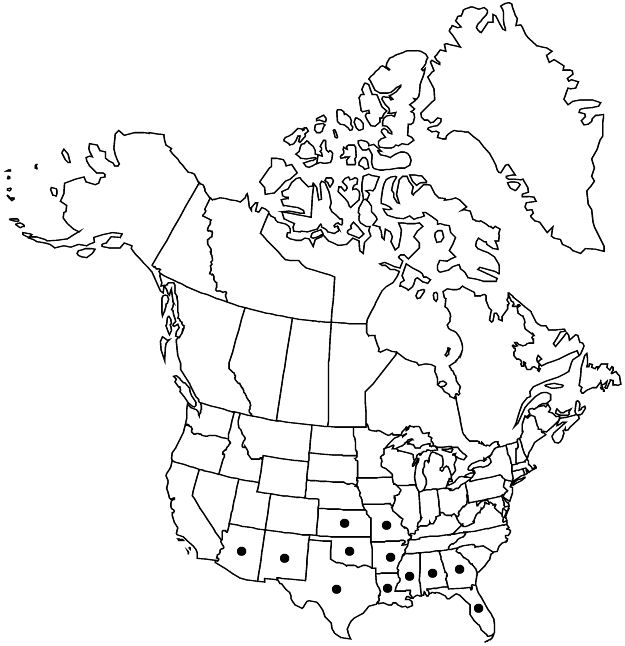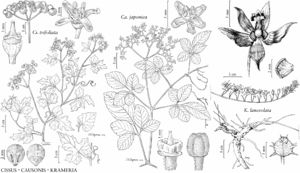Difference between revisions of "Cissus trifoliata"
Syst. Nat. ed. 10, 2: 897. 1759. (as trifoliat)
FNA>Volume Importer |
imported>Volume Importer |
||
| (6 intermediate revisions by 2 users not shown) | |||
| Line 6: | Line 6: | ||
|place=10, 2: 897. 1759 | |place=10, 2: 897. 1759 | ||
|year=1759 | |year=1759 | ||
| + | |other_info_on_pub=(as trifoliat) | ||
}} | }} | ||
|common_names=Marine vine or ivy;sorrell vine;hierba del buey;ivy treebine | |common_names=Marine vine or ivy;sorrell vine;hierba del buey;ivy treebine | ||
|special_status={{Treatment/ID/Special_status | |special_status={{Treatment/ID/Special_status | ||
|code=F | |code=F | ||
| − | |label= | + | |label=Illustrated |
}} | }} | ||
| − | |basionyms={{Treatment/ID/ | + | |basionyms={{Treatment/ID/Basionym |
|name=Sicyos trifoliatus | |name=Sicyos trifoliatus | ||
|authority=Linnaeus | |authority=Linnaeus | ||
| + | |rank=species | ||
| + | |publication_title=Sp. Pl. | ||
| + | |publication_place=2: 1013. 1753 | ||
}} | }} | ||
|synonyms={{Treatment/ID/Synonym | |synonyms={{Treatment/ID/Synonym | ||
|name=Cissus incisa | |name=Cissus incisa | ||
|authority=Des Moulins | |authority=Des Moulins | ||
| + | |rank=species | ||
}} | }} | ||
|hierarchy=Vitaceae;Cissus;Cissus trifoliata | |hierarchy=Vitaceae;Cissus;Cissus trifoliata | ||
| Line 34: | Line 39: | ||
|elevation=0–2000 m. | |elevation=0–2000 m. | ||
|distribution=Ala.;Ariz.;Ark.;Fla.;Ga.;Kans.;La.;Miss.;Mo.;N.Mex.;Okla.;Tex.;Mexico;West Indies;Central America;n South America. | |distribution=Ala.;Ariz.;Ark.;Fla.;Ga.;Kans.;La.;Miss.;Mo.;N.Mex.;Okla.;Tex.;Mexico;West Indies;Central America;n South America. | ||
| − | |discussion=<p>Many previous authors treated Cissus incisa and C. trifoliata as distinct species, but the characters used to separate them (size of leaflets, branching patterns of cymes, and berry shape) appear to intergrade abundantly, particularly in Florida, where their geographical ranges overlap. It appears that much of the basis for separating these two species is geographical distribution and habitat, with C. trifoliata being chiefly coastal and tropical and C. incisa being chiefly subtropical and temperate continental. Some authors (for example, R. P. Wunderlin 1982; R. K. Godfrey 1988; J. A. Lombardi 2000) therefore have treated C. incisa as a synonym of C. trifoliata, a conclusion that is followed here.</p> | + | |discussion=<p>Many previous authors treated <i>Cissus</i> incisa and <i>C. trifoliata</i> as distinct species, but the characters used to separate them (size of leaflets, branching patterns of cymes, and berry shape) appear to intergrade abundantly, particularly in Florida, where their geographical ranges overlap. It appears that much of the basis for separating these two species is geographical distribution and habitat, with <i>C. trifoliata</i> being chiefly coastal and tropical and C. incisa being chiefly subtropical and temperate continental. Some authors (for example, R. P. Wunderlin 1982; R. K. Godfrey 1988; J. A. Lombardi 2000) therefore have treated C. incisa as a synonym of <i>C. trifoliata</i>, a conclusion that is followed here.</p> |
|tables= | |tables= | ||
|references= | |references= | ||
| Line 43: | Line 48: | ||
-->{{#Taxon: | -->{{#Taxon: | ||
name=Cissus trifoliata | name=Cissus trifoliata | ||
| − | |||
|authority=(Linnaeus) Linnaeus | |authority=(Linnaeus) Linnaeus | ||
|rank=species | |rank=species | ||
| Line 57: | Line 61: | ||
|publication title=Syst. Nat. ed. | |publication title=Syst. Nat. ed. | ||
|publication year=1759 | |publication year=1759 | ||
| − | |special status= | + | |special status=Illustrated |
| − | |source xml=https:// | + | |source xml=https://bitbucket.org/aafc-mbb/fna-data-curation/src/2e0870ddd59836b60bcf96646a41e87ea5a5943a/coarse_grained_fna_xml/V12/V12_206.xml |
|genus=Cissus | |genus=Cissus | ||
|species=Cissus trifoliata | |species=Cissus trifoliata | ||
Latest revision as of 19:14, 5 November 2020
Lianas, stout, scrambling or sprawling over low vegetation or small trees. Branches usually glabrous; branchlets succulent when young, becoming woody, sometimes rooting at nodes; growing tips usually glabrous; tendrils unbranched. Leaves usually 3-foliolate, sometimes simple; petiole usually shorter than blade; blade succulent, broadly ovate to ovate-reniform, 2–8 × 2–7 cm, if simple usually 3-lobed, rarely unlobed, margins coarsely and irregularly toothed, surfaces glabrous; leaflets (compound leaves) ovate to oblong. Flowers greenish, greenish yellow, whitish, or purplish. Berries black to blue-black, 6–12 mm diam.
Phenology: Flowering late Apr–Jun; fruiting Aug–Sep.
Habitat: Rocky wooded hillsides, stream banks, prairie ravines, glades, bluffs, chaparral, coastal hammocks and dunes, maritime woodlands, shell mounds in salt marshes, roadsides, waste places.
Elevation: 0–2000 m.
Distribution

Ala., Ariz., Ark., Fla., Ga., Kans., La., Miss., Mo., N.Mex., Okla., Tex., Mexico, West Indies, Central America, n South America.
Discussion
Many previous authors treated Cissus incisa and C. trifoliata as distinct species, but the characters used to separate them (size of leaflets, branching patterns of cymes, and berry shape) appear to intergrade abundantly, particularly in Florida, where their geographical ranges overlap. It appears that much of the basis for separating these two species is geographical distribution and habitat, with C. trifoliata being chiefly coastal and tropical and C. incisa being chiefly subtropical and temperate continental. Some authors (for example, R. P. Wunderlin 1982; R. K. Godfrey 1988; J. A. Lombardi 2000) therefore have treated C. incisa as a synonym of C. trifoliata, a conclusion that is followed here.
Selected References
None.
